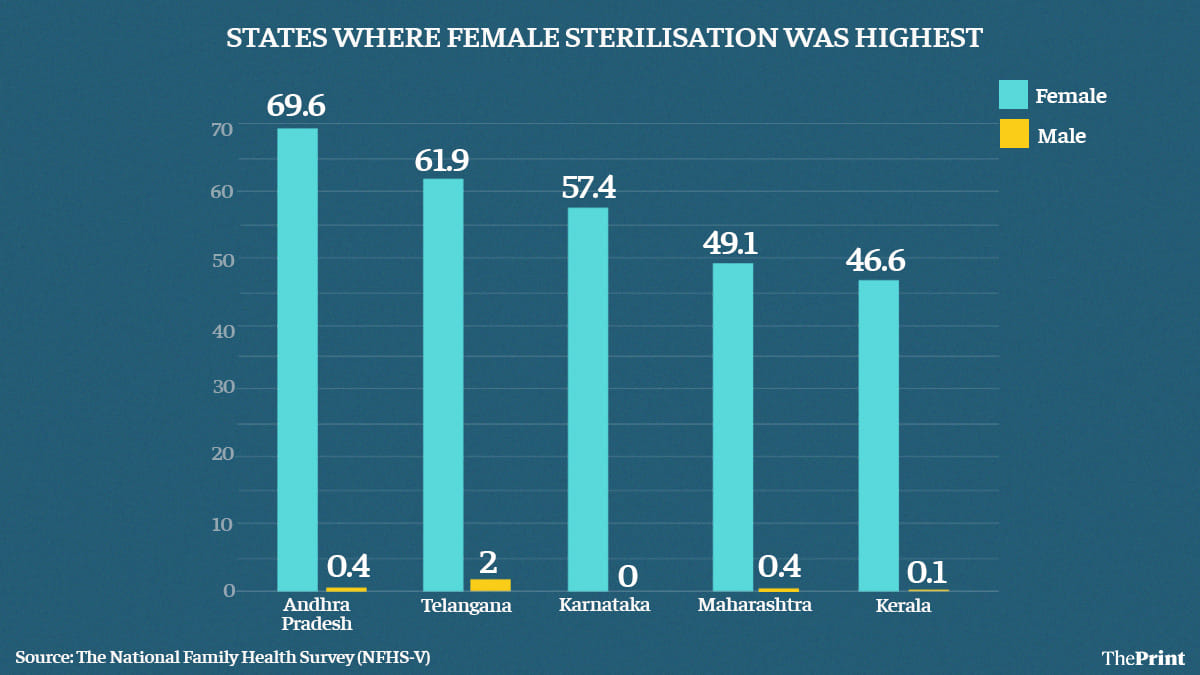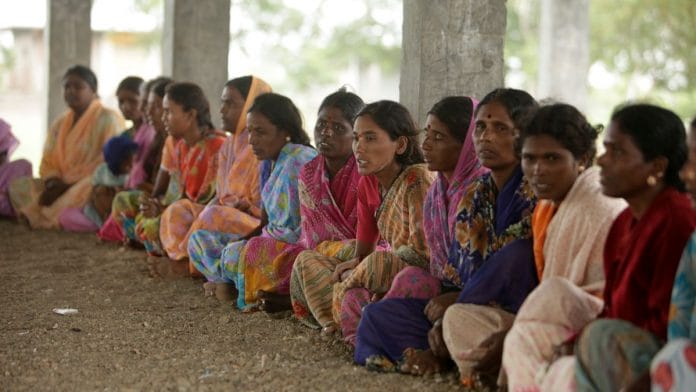New Delhi: The National Family Health Survey (NFHS), which was partially released last week, has once again found that a disproportionate number of women end up opting for sterilisations than men.
The “multi-round survey”, first conducted in 1992-1993, provides crucial information on fertility, infant and child mortality as well as family planning.
According to the survey, the proportion of women with unmet need for family planning had declined in all surveyed states, apart from Meghalaya and Andhra Pradesh.
The first findings of NFHS-5 show significant discrepancies between female and male sterilisations in all the 22-surveyed states and union territories.
The state with the highest discrepancies is Andhra Pradesh, followed by Telangana and Karnataka.

Highlighting the discrepancy, the Population Foundation of India (PFI) in a statement Wednesday, noted: “Male engagement in family planning continues to be limited and disappointing as seen by the low uptake of condoms and male sterilisation across states.”
“The public health system engages primarily with women and no men. Men tend not to participate in discussions about family planning and the onus is on women to use contraceptives,” Poonam Muttreja, PFI’s Executive Director, told ThePrint.
Also read: If Modi govt wants to control population, it must target high fertility rates in these states
History of sterilisation
While the seeds of sterilisation were sowed during the colonial era, population control only took an aggressive turn under former prime minister Indira Gandhi.
As many would recall, during the 1975 Emergency, Gandhi initiated a sterilisation campaign largely targeting poor men. Researchers Nilanjana Chatterjee and Nancy E. Riley in their 2001 paper, titled ‘Planning an Indian Modernity: The Gendered Politics of Fertility Control’, traced the roots of the policy back to the drought and economic crisis of 1966.
The government was then compelled to seek help from the World Bank and the Lyndon B. Johnson administration in the US, who then pressured India to intensify the fertility reduction efforts out of fear that population growth posed a threat to US trade and national security.
Thus the mass sterilisation programme started, and in 1977, the number of sterilisations had increased to 8.1 million in India from 2.6 million the previous year.
During the post-Emergency period, as protests against the coercive policy toppled the Indira Gandhi government, family planning policy in India underwent a drastic shift.
“The programme virtually collapsed in 1977-78 and when it recovered, its focus shifted exclusively to women,” researcher T.K. Sundari Ravindran noted in his paper ‘Women and the Politics of Population and Development in India’.
A report in 2018 by independent writer and audio producer Hannah Harris Green talked about a 1980 Indian government working group on population policy that said that women should be the focus of the family planning efforts “in the short run”.
Ravindran’s paper stated that female sterilisations came to constitute about 85 per cent of the total sterilisation in most parts of the 1980s.
The policy now
Even after 40 years, little seems to have changed.
The Ministry of Health’s Annual Report for 2018-2019 showed that the “Key Strategies” under the section on ‘Family Planning’ largely includes programmes and services that either target women or the family unit. These include the injectable contraceptive programme, Postpartum Intrauterine Contraceptive Device (PPIUCD) services and “saas bahu sammelans” to “encourage communication between women and their mother-in-laws”.
The issue of the low uptake of vasectomies features in the bottom of the government’s “key strategies”, with a suggestion to hold a ‘Vasectomy Fortnight’ awareness event in all states in the month of November every year.
In 2019, however, the government issued a notice on “Family Planning for Males” highlighting male-centric initiatives that included training of service providers, ‘Home Delivery of Contraceptive Scheme’ and increased compensation for male sterilisation.
Muttreja said this might prove to be insufficient as a study had indicated that healthcare workers at that institutional level lack knowledge about policies that stress the importance of men’s engagement.
“Efforts at the institutional level to increase men’s engagement have been inconsistently implemented,” she added.
It’s thus not very surprising to note that since the first NFHS survey, the proportion of female sterilisation increased from 30.8 per cent (NFHS-1 in 1992-1993) to over 36 per cent (NFHS-4 in 2015-2016). Meanwhile, male sterilisation has consistently declined from 4 per cent to 0.3 per cent in the same period.
In 2014, this especially became a cause for concern after 13 women died following their sterilisation at a camp in Chhattisgarh’s Bilaspur.
An investigation by PFI into the incident had revealed that the state government spent 20 times the amount to incentivise women to get the procedure done than on the surgery itself.
“Engaging men in family planning programming is critical not only to create a base of well-informed users, but also their understanding of family planning will enhance women’s use of contraception both directly and indirectly,” Muttreja said.
Also read: After flak, MP govt withdraws its ‘get at least one man to sterilise or lose job’ order
‘A patriarchal mindset’
President-elect of the Federation of Obstetric and Gynaecological Societies of India, Dr Shantha Kumari, pointed out another factor behind more women going for sterilisation than men.
“Female sterilisation takes longer and (is) more invasive compared to vasectomy, which is more simple and easy. But the patriarchial mindset creates a social barrier, which prevents our men (from) volunteering and accepting vasectomy,” she said.
“I’ve seen all categories of patients… the female patients when they come to us, we advise them that your husband can get the vasectomy done. But it becomes a very sensitive issue and most of the time the female isn’t keen for her husband to get a vasectomy,” said Kumari, who is a consultant at Yashoda Hospital in Hyderabad and had previously worked at Deccan Medical College.
Echoing a similar sentiment, PFI’s Muttreja said that “gender and social norms greatly influence men’s acceptance of family planning in general and of specific contraceptive options”.
“In India, many men resist vasectomy due to myths that the procedure causes physical weakness or impotence, and reduces a man’s capability to provide for his household.”
She added: “An effective way to address these social norms is through well-designed, and engaging social and behaviour change communication programmes.”
Also read: Two-child policy law will be impractical, damage growth, violate rights, say experts






